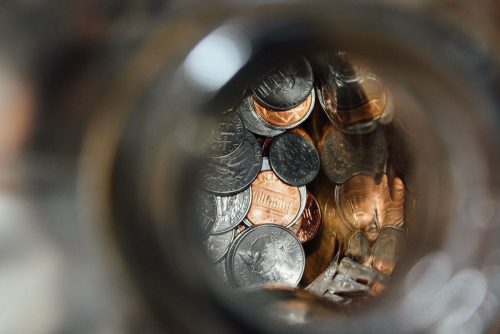
I was listening to an older episode of the Rich Roll podcast recently with Michael Easter, author of the excellent bestselling book The Comfort Crisis (<–affiliate link). Early in the podcast Easter said something that resonated with me in many…
The post Today’s Comfort Is Going To Be Tomorrow’s Discomfort appeared first on Accidental Fire.

rsfg
Why I Invest in Dividend Stocks
I invest in dividend stocks to grow a my passive income with dividend income. One day, my dividend income will be large enough to cover my monthly expenses and allow us to retire early. That is why we are always relentlessly searching for undervalued dividend stocks to buy. To put our hard earned cash to work.
We save a high percentage of our income each month, to help fuel our dividend stock portfolio. Having a high savings rate is a key pillar of our strategy and helps fuel the fire and push the snowball further down hill. While we are waiting to invest our money in the market, it is earning a high interest rate in accounts. There is NOTHING more critical than maximizing EVERY DOLLAR in your savings account.
READ: How To Maximize Your Cash – 4 Simple Methods!
The 3 primary savings accounts I use are:
-
- SoFi – 4.3% APY on all savings accounts (lower for your checking account). The race for deposits is INTENSE! Banks and credit unions are offering great savings rates.
- Capital One 360 Savings – 4.00% APY – We use Capital One for our checking and savings account.
- Wealthfront – 4.5% without promotion. 5.0% with an extra .5% by signing up using my referral link (Click Here).
Read: Interest Rates on High Yield Savings Accounts Are SOARING!
Bert’s JULY Dividend Income Summary
In September 2024, we received $4,333.04 in dividend income! This was a 21.34% increase compared to last year.
September is a major month for mutual fund and ETF payments. That is why it is one of our favorite months to follow and watch the dividend income flow in from all sources. For us, it was essentially an even split for stocks and mutual funds. 53% of our income came from individual stocks while 47% came from ETFs or mutual funds.
The devil is in the details though. The following charts share the individual dividends we received from our dividend stock positions, mutual funds, and ETFs.
Dividend income Observations
We share a few observations each month about our dividend income total for the month.
Observation #1: Johnson & Johnson is Still On Top
My wife and I each purchased 100 shares of Johnson & Johnson over a 2 year stretch in 2021 – 2023. This is by far our largest individual paying dividend stock position in our portfolio. We are each DRIPing approximately 1 share every quarterly dividend. The positions are continuing to grow without us lifting a finger. It is really nice to have massive positions hat produce such large dividend payments.
Observation #2: The SCHD Dividend Is Really Growing
We are buying between 15-20 shares of SCHD every single week for my wife. After the big SCHD share split, my wife’s position is closing in on 1,000 shares of the dividend investing communities favorite dividend ETF. Next quarter – that dividend should hopefully be massive!
Observation #3: Loving Some High Quality Dividend Payments
We always talk about how we need to trim down our dividend stock positions. The chart above clearly shows a large number of dividend stock positions in our portfolio. I would love to trim some down, especially the lower dividend paying stocks. However, it is always nice to see the high quality names that sit atop our dividend stock portfolio.
We receive dividend checks from plenty of Dividend Kings, Dividend Aristocrats, and other major players. Target, Johnson & Johnson, Realty Income, T.Rowe Price, Archer Daniels Midland, Aflac, Lockheed Martin, are just some of the big names that paid us this month.
This is why we buy dividend stocks and great companies. The sense of satisfaction and pride that you get when you receive those individual dividend checks!
Summary
September’s dividend income is in the books. Like so many earlier months, I couldn’t be happier with our progress we make towards financial freedom. Step by step, dollar by dollar, we are cruising towards early retirement. Months like these motivate us to save every possible dollar and keep pushing. Onward and upward.
Did you have strong dividend income total’s this month? How much September dividend income did you receive?
Bert
(adsbygoogle = window.adsbygoogle || []).push({});
The post Bert’s September Dividend Income Summary (2024) appeared first on Dividend Diplomats.

My main goal* was to build an investment and cash portfolio of $1,120,000* ($1,000,000 to retire on and $120,000 to pay off the house) in 1500 days**, starting from 1/1/2013 and ending in February of 2017. I made my goal in 2016, my 1500 Days are over, and I’ve left my job. In the interest of openness, I’ll continue to share […]
The post Performance Update: September 2024, All-Time High! appeared first on 1500 Days to Freedom.

The stock market outlook maintains an uptrend, with all three indicators continuing to show bullish performance for U.S. equities.

The kitchen is often the biggest battleground in the war against rising living costs. From groceries and utilities to meal prep and storage, it’s easy for expenses to pile up (even for a frugalista like me!). However, with a bit of creativity and some old-fashioned know-how, your kitchen can become a hub of frugal living. Using these kitchen money-saving hacks, saving money in the kitchen doesn’t have to be complicated. By adopting simple habits and strategies, you can significantly reduce waste, stretch your food budget, and maximize the value of every ingredient you buy.
This comprehensive post offers over 50 practical kitchen money-saving hacks designed to help you save money without sacrificing lifestyle quality or taste. From meal planning and smart shopping to DIY solutions and creative ways to repurpose leftovers, these tips are perfect for anyone looking to make their kitchen more efficient and budget-friendly. Whether you’re a seasoned, frugal living enthusiast or just starting your journey toward more mindful spending, these hacks will empower you to take control of your kitchen costs and make every dollar count.
*This post may contain affiliate links, which means that if you buy a suggested product, I will earn a small commission, at no extra cost to you. For more information, see my disclosure page.
Kitchen Money-Saving Hacks That Will Stretch Your Grocery Dollars
Plan Your Meals Around Sales
Weekly sales flyers are goldmines for savings. Design your meal plan based on items that are on sale, especially staple foods. This approach not only maximizes discounts but also encourages you to diversify your meals based on seasonal and discounted items.
Create a Weekly Meal Plan
Planning meals in advance helps avoid buying items you won’t use. By creating a meal plan, you can strategically use ingredients across multiple meals, ensuring that nothing goes to waste. It also helps you stick to a budget, as you know exactly what you need to buy.
You might be interested in : Reverse Meal Planning: Easy Solutions To Save Time And Money
Shop with a List and Stick to It
- Impulse purchases can quickly add up. Sticking to a list helps you avoid grabbing unnecessary items and stay within your budget. A well-prepared list based on your meal plan ensures you’re buying only what’s needed.
- If you have grocery pickup available to you, this is a great way to stick to your list, resist impulse purchases AND stay in line with your budget.
Buy in Bulk for Staples
Bulk buying is cost-effective for non-perishable staples like rice, oats, pasta, and canned goods. Just be sure to store these items properly in airtight containers to avoid spoilage and pest infestation.
Use Your Freezer Wisely
The freezer can be your best friend when it comes to extending the life of foods. Freeze leftovers, bread, fresh herbs in olive oil, and even cheese to prevent spoilage and save money on groceries. Freezing leftovers is one of many great kitchen money-saving hacks that prevents waste and ensures you always have something ready to eat.
Invest In An Extra Freezer
An extra freezer allows you to buy in bulk, store extra meals, and freeze garden produce. It helps you save by reducing the number of trips to the store and taking advantage of sales.
Cook Once, Eat Twice (or More)
Batch cooking allows you to make several meals in one go, saving time and money. For example, making a large pot of chili can provide multiple meals throughout the week. You can also freeze portions for future use.
Repurpose Leftovers Creatively
Don’t let leftovers languish in the fridge. Turn them into new dishes, such as using leftover rice for fried rice, roasting leftover vegetables for a frittata, or transforming last night’s pasta into a baked casserole.
Make Your Own Stock
Save vegetable scraps like carrot tops, onion skins, and celery ends, along with bones from meats, to make homemade stock. It’s a frugal way to add flavor to soups, stews, and risottos without buying store-bought broth.
Store Produce Properly
Different fruits and vegetables require different storage methods. For example, store potatoes and onions separately in a cool, dark place. Wrap lettuce in a paper towel before placing it in a container to absorb moisture and keep it crisp longer. Avocados will stay fresh for weeks by submerging them in water in a large mason jar and storing in the refrigerator. You can also extend the life of strawberries by storing in an airtight container in the refrigerator. (Don’t wash strawberries until you’re ready to use them.)
Keep an Organized Pantry
Keeping your pantry well-organized is one of the best kitchen money saving hacks. It helps you easily see what you already have, which prevents unnecessary duplicate purchases. By using clear containers, labels, and arranging items by category, you can quickly find what you need and reduce food waste
A great organizing tip is to use the “first in, first out” method, where you place newly bought items at the back and older ones in the front to ensure everything gets used up.
Grow Your Own Herbs
Fresh herbs can be expensive, and they often go bad before you use them up. Growing your own in small pots or a garden not only saves money but also ensures a constant supply of fresh herbs. Grab your seed packets from the Dollar Tree in the Spring for only .25 cents/each. They’re great!
Buy Generic Brands
Store brands are often just as good as name brands but cost significantly less. Compare ingredients and nutritional content to ensure you’re not sacrificing quality for savings.
Learn to Love Your Slow Cooker
Slow cookers use less electricity than an oven or stove and can make delicious meals from inexpensive ingredients. The low-and-slow cooking process also tenderizes tougher cuts of meat. Mine is a necessary staple in my kitchen and I use it every week. It so easy to ‘dump’ the ingredients in it in the morning, turn it on and walk away until dinnertime!
Hamilton Beach 6 Qt. Slow Cooker
You may be interested in: The Best Cheap And Easy Slow Cooker Meals
Use Less Meat
Make meat a side instead of the star of the show! Meat is often the most expensive component of a meal so, that’s why this may be one of the most important kitchen money-saving hacks that can really stretch your grocery dollars. Incorporating more plant-based proteins, such as beans, lentils, and chickpeas, can lower costs while still providing nutritious and filling meals.
Make Your Own Bread
Baking bread at home is not only cost-effective but also allows you to control the ingredients for a healthier loaf. It’s a great activity to try if you enjoy baking or are looking for ways to reduce grocery costs.
Avoid Pre-Packaged and Pre-Cut Produce
Pre-packaged and pre-cut fruits and vegetables come at a premium price. Buying whole produce and cutting it yourself saves money and gives you more control over freshness.
Use a Shopping Price Book
A price book helps you track the cost of items you frequently buy, allowing you to spot trends and stock up when prices are at their lowest. It’s a simple tool that can make a big difference in your budget.
Embrace Meatless Mondays
Dedicate one day a week to plant-based meals. It’s a great way to reduce your grocery bill and explore new vegetarian recipes. Popular dishes include lentil soups, pasta primavera, and vegetable stir-fry.
Make Your Own Salad Dressings and Sauces
Store-bought dressings and sauces are convenient but expensive. Simple homemade dressings using ingredients like olive oil, vinegar, mustard, and spices are more affordable and customizable.
Use Reusable Storage Solutions
Invest in quality containers. While the upfront cost may be higher, they’ll save money over time by eliminating the need for disposable plastic wraps and bags. High-quality containers with tight seals prevent spoilage and freezer burn, helping you get the most out of your food. Choose containers that are stackable and see-through for easy storage and organization. Beeswax wraps and silicone bags are also great storage options.
56 Piece Food Storage Containers W/ Airtight Lids
Eat Seasonally
Seasonal produce is usually cheaper and fresher. Learn which fruits and vegetables are in season and adjust your meal plans accordingly to take advantage of the best prices.
Regrow Vegetables from Scraps
Many vegetables, such as green onions, lettuce, and celery, can be regrown from scraps. Place the cut base in a small bowl of water and watch it sprout in just a few days.
Make Your Own Cleaning Products
Homemade cleaners using common household ingredients like vinegar, baking soda, and lemon juice are just as effective as commercial products but at a fraction of the cost.
Check out this post for several great homemade cleaning recipes: Frugal House Cleaning Tips-Easy, Practical Ways To Save Money
Use Cloth Napkins and Towels
Switching to cloth napkins and kitchen towels reduces the need for disposable paper products. It’s an eco-friendly choice that will save money over time.
Limit Food Delivery and Takeout
Cooking at home is much cheaper than eating out. Save restaurant meals for special occasions and focus on making quick and simple dishes during busy times.
Buy Frozen Vegetables and Fruits
Frozen produce is often cheaper than fresh and can be stored for longer without spoiling. It’s a convenient option for recipes where texture isn’t as important, such as soups and smoothies.
Make Your Own Seasoning Blends
Pre-made spice blends often cost more than the individual spices used to make them. Creating your own spice blends is one of the best effective kitchen money-saving hacks that can save a lot over time, and you can adjust the flavors to suit your tastes.
Set Up a Leftovers Night
Dedicate one night each week to eating leftovers. It prevents food waste, saves time, and gives you a night off from cooking.
Preserve Excess Produce
If you find a great deal on produce or have a bountiful garden, consider canning, drying, or pickling the excess. Preserving food extends its shelf life and reduces waste.
Start a Compost Bin
Instead of throwing out food scraps, compost them. You’ll reduce waste and create nutrient-rich soil for your garden, which can help you grow your own herbs and vegetables.
Use a Water Filter Instead of Bottled Water
Bottled water is convenient but costly over time. A water filter provides clean drinking water at a fraction of the cost and helps reduce plastic waste.
Skip Single-Use Items
Items like disposable plates, cutlery, and coffee pods may be convenient but are not cost-effective. Opt for reusable items to cut costs and reduce waste.
Make Your Own Snacks
Homemade snacks are not only healthier but also cheaper than store-bought options. Try making granola bars, energy bites, or seasoned popcorn for an affordable treat.
Repurpose Food Scraps
Use vegetable peels for stock, turn stale bread into croutons, or dry out orange peels for homemade potpourri. Finding creative uses for scraps reduces waste and maximizes food value.
Shop Discount Grocery Stores
Discount stores (like Aldi) often offer lower prices on quality products. Familiarize yourself with their selection and save by shopping there for staple items.
Buy Whole Chickens Instead of Cuts
Whole chickens are usually cheaper than buying pre-cut pieces. Roast the whole bird, use the leftovers for different meals, and make stock from the bones for added value.
Repurpose Glass Jars and Containers
Save jars from pasta sauces, pickles, and other groceries. They make excellent storage containers for dry goods, leftovers, or homemade sauces, reducing the need to buy additional storage solutions.
Shop with Cash
This is the king of the kitchen money-saving hacks, in my opinion. Paying with cash can help you stick to your budget, as you’re more conscious of the amount being spent. It’s a physical reminder of how much you have left and it definitely helps to prevent overspending.
Buy Produce Directly from Farmers
Purchasing produce at farmers’ markets or directly from local farms can be cheaper than buying at grocery stores. It’s also a great way to support local agriculture.
Batch Bake for Energy Savings
Batch baking is one of those smart kitchen money-saving hacks that allow you to bake multiple items at once and save energy. For instance, you could bake bread, a casserole, and cookies in the same oven session.
Prepare Simple Pantry Meals
Keep ingredients on hand for easy, inexpensive meals made from pantry staples. This could be as simple as pasta with tomato sauce or rice and beans. It helps avoid takeout when you’re short on time.
Choose In-Season Fish
Seafood can be expensive, but choosing varieties that are in season or on sale can reduce costs. Canned fish like tuna and salmon are also budget-friendly options.
Join a Community Garden
If you lack space for a garden at home, consider joining a community garden. You’ll gain access to fresh produce and have a chance to learn more about growing your own food.
Plan for Leftover Ingredients
Another kitchen money-saving hack is to plan for leftover ingredients when a recipe calls for a specific ingredient that you don’t often use, make a plan to use the leftovers in other meals. For example, if you buy a bunch of cilantro for a recipe, plan another dish that also uses cilantro.
Repurpose Stale Bread
Don’t throw out stale bread—it still has plenty of uses. You can blend it into breadcrumbs for breading or stuffing, make croutons for soups and salads, or transform it into French toast or bread pudding. These options not only prevent waste but also save money on buying additional ingredients.
Stretch Dairy Products
Dairy items like milk, cream, and cheese can be extended to last longer and go further. For example, you can dilute heavy cream with a bit of milk to use in recipes calling for light cream, or add cornstarch to grated cheese to help it stay fresh and clump-free for longer. You can even add a small amount of water to milk for baking purposes, which won’t affect the recipe’s outcome.
Use a Small Spoon for Spreads
Spreads like peanut butter, jam, and mayonnaise tend to get used up quickly if you scoop them out with large utensils. Using a smaller spoon helps you take just enough without overdoing it. This not only conserves the product but also helps control portion sizes and calorie intake.
Buy Spices in Bulk
Spices in bulk are often significantly cheaper than those sold in small jars, and you can buy exactly the amount you need. Ethnic grocery stores frequently offer a wider variety of bulk spices at lower prices. Properly store spices in airtight containers to ensure they maintain their flavor for an extended time.
Make Your Own Coffee
Brew your own coffee at home instead of visiting coffee shops. Invest in a good-quality coffee maker or try a manual method like a French press. You can experiment with different beans and brewing techniques for a perfect cup of coffee at a fraction of the cost of daily takeout.
Use the Last Bits in Jars
Don’t toss out nearly-empty jars of condiments like mustard, honey, or peanut butter. You can add vinegar, olive oil, or water to make a salad dressing or sauce right in the jar. This ensures you use up every last bit and adds extra flavor to your meals.
Keep an “Eat Me First” Bin in Your Fridge
Designate a spot in the fridge for items that are nearing their expiration dates. Label this bin as “Eat Me First” to encourage everyone to consume these foods before they spoil. This small habit can significantly reduce food waste and save money on groceries.
Store Nuts and Seeds in the Freezer
Nuts and seeds contain natural oils that can turn rancid if stored at room temperature for too long. Freezing them helps extend their shelf life and maintains their freshness. Store them in airtight containers or freezer bags to keep them at their best.
Use a Food Dehydrator
A food dehydrator allows you to preserve a variety of foods, from fruits and vegetables to herbs and even meats. Dehydrating food prevents spoilage, reduces the need to buy prepackaged snacks, and allows you to take advantage of seasonal produce by storing it for later use.
Reheat Food the Right Way
Leftovers can taste just as good as freshly made meals if you reheat them correctly. Avoid the microwave for certain foods that may turn mushy, such as pizza or roasted vegetables, and instead, use the oven or stovetop to warm foods up evenly and restore their original texture. Investing a bit more time in reheating can make leftovers more appealing and reduce the temptation to order takeout.
Final thoughts…
By applying these kitchen money-saving hacks, you can transform your kitchen into a more frugal and efficient space, over time. The key is consistency—small changes, when practiced regularly, add up to significant cost reductions and less waste. By being intentional with your grocery shopping, meal prep, and how you store food, you not only stretch your budget but also cultivate a lifestyle that values resourcefulness and sustainability.
As you begin to embrace these frugal habits, you’ll find that your kitchen becomes a place of creativity and satisfaction, where delicious meals are prepared with care and thriftiness. With over 50 tips/hacks to guide you, you’ll be well on your way to building a kitchen that works smarter, saves money, and brings more joy to the simple pleasures of home-cooked meals.
Do you have any kitchen money-saving hacks that I didn’t mention in this post? If they aren’t on this list, please share in the comments. I’d love to hear what they are!
For more money-saving tips and strategies, be sure to subscribe to our newsletter at Love to Frugal! You can also follow me on Pinterest, Facebook & Instagram for even more money saving, frugal living tips!
Other posts you may be interested in:
Hidden Costs Of Convenience: How It’s Draining Your Finances
Old Fashioned Frugal Homemaking Tips Guaranteed To Still Work
How to Cut Monthly Expenses: 20 Practical Tips for Saving Money
The post Practical Kitchen Money-Saving Hacks For Lowering Your Grocery Bill appeared first on Love To Frugal.

Send us a text Join us on Average Joe Finances as our guest Mark Miller, the CEO of Hilton Tax and Wealth Advisors, discusses his career and collaboration with the Hilton family, highlighting the importance of advanced tax mitigation strategies that can significantly reduce tax liabilities and enhance wealth for business owners and high-income earners. […]
The post Podcast 274. Expert Tax and Wealth Strategies with Mark Miller appeared first on Average Joe Finances.

Hey folks! It’s good to be talking to you again this Weekender.
If you’ve been watching the feed (you can find it here), you know that I’ve been updating the Income posts for 20241 data. Here’s a catalog of what I’ve finished so far:
- Defining the One Percent
- Household Income by Year
- Household Income (calculator)
- Individual Income (calculator)
- Individual Income by Age (calculator)
- Individual Income by Year
- Individual Income by Race
- Individual Income by Sex
- Individual Income by Education
- Salary by Age (calculator)
- Salary (calculator)
I owe you a couple: the State and City breakdowns. They are the hardest, so they aren’t done yet (ha). And there are no US Net Worth updates until (probably) 2026, the next time I expect new SCF data.
After that, most of your requests are for more investment calculators. I’ll see what I can build there with my current data sources, then maybe explore a little. But keep the ideas coming!
1 It comes up often – 2024 data is “full year 2023 data”. The CPS ASEC is in the field in the Spring, and asks about what people earned in the previous year. But that’s okay; if you asked about 2024 full-year data, it’d just be a projection at this point anyway.
Home
If you’ve been following my sporadic Weekenders, you know I bought more projects than I expected with this house. Since we’re rapidly approaching winter, I’ve been knocking out as many outdoor projects as possible.
You’ll be happy to know that after all of the work replacing the deck boards, we laid down some stain:
It’s pretty funny that you can still tell which boards were replaced – but the older ones were solid (believe me, we checked everything closely). And yeah, it’s funny now looking back, but with the number I replaced in the last two years, we probably should have just gone composite. For the railings, we’re thinking of PVC or Composite, and due to the existing spans, we’re looking at Barrette Outdoor Living’s and Envision Outdoor’s lines. We’d keep the current 4×4 posts.
Let me know if you have any experience with them, one way or the other.
I’m also cutting in for low-voltage deck lights. Here, I’ll do 3 1″ insets. And I’m paranoid about water getting in the holes, I did end up staining everything I drilled:
This is now our third Fall in New Hampshire. It’s beautiful here – check out the colors from a walk we did the other day:
Hope all is well with you!
The post The DQYDJ Weekender, 10/27/2024 appeared first on DQYDJ – Don’t Quit Your Day Job….

Set Monthly or Quarterly Reviews: Regularly reviewing your budget and savings rate helps you stay on track and adjust for any life changes.
Challenge Yourself to Find New Savings: Periodically look for additional ways to save, such as finding a lower phone plan, switching to a cheaper internet provider, or taking advantage of seasonal discounts.

Sometimes, a breakthrough can happen with the right opportunity or insight. Here are common ways people experience financial breakthroughs:
Career Advancement: Finding a higher-paying job, getting a promotion, or starting a successful business can significantly increase income.
Side Hustle Success: Building a side income stream that grows into a substantial source of passive income.
Windfalls: Inheritance, settlement, or selling an asset for a profit can provide an unexpected financial boost, though it’s best used wisely to support long-term goals.
Investment Returns: A successful investment, whether in stocks, real estate, or a startup, can lead to a breakthrough. Building a diversified portfolio and investing consistently improve the chances of growth.
A financial breakthrough is as much about mindset and consistency as it is about numbers. With clarity, disciplined savings, strategic investments, and regular financial check-ins, you’re more likely to experience that breakthrough moment.

A financial breakthrough can be transformative, often marking a major shift in personal finance or wealth-building. It could mean becoming debt-free, hitting a major savings milestone, or discovering a more profitable career path. If you’re looking to achieve a financial breakthrough, here are steps and strategies to help guide you toward that goal.
Set a Clear Financial Goal
Get Serious About Budgeting
Prioritize High-Interest Debt
Maximize Your Income Streams
Increase Your Savings Rate
Invest for Long-Term Growth
Build an Emergency Fund
Seek Out Tax-Advantaged Accounts
Cultivate a Financial Breakthrough Mindset
Be Consistent and Stay Adaptable
